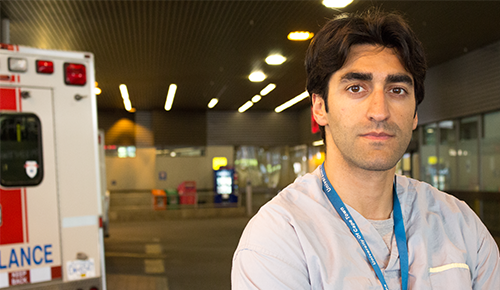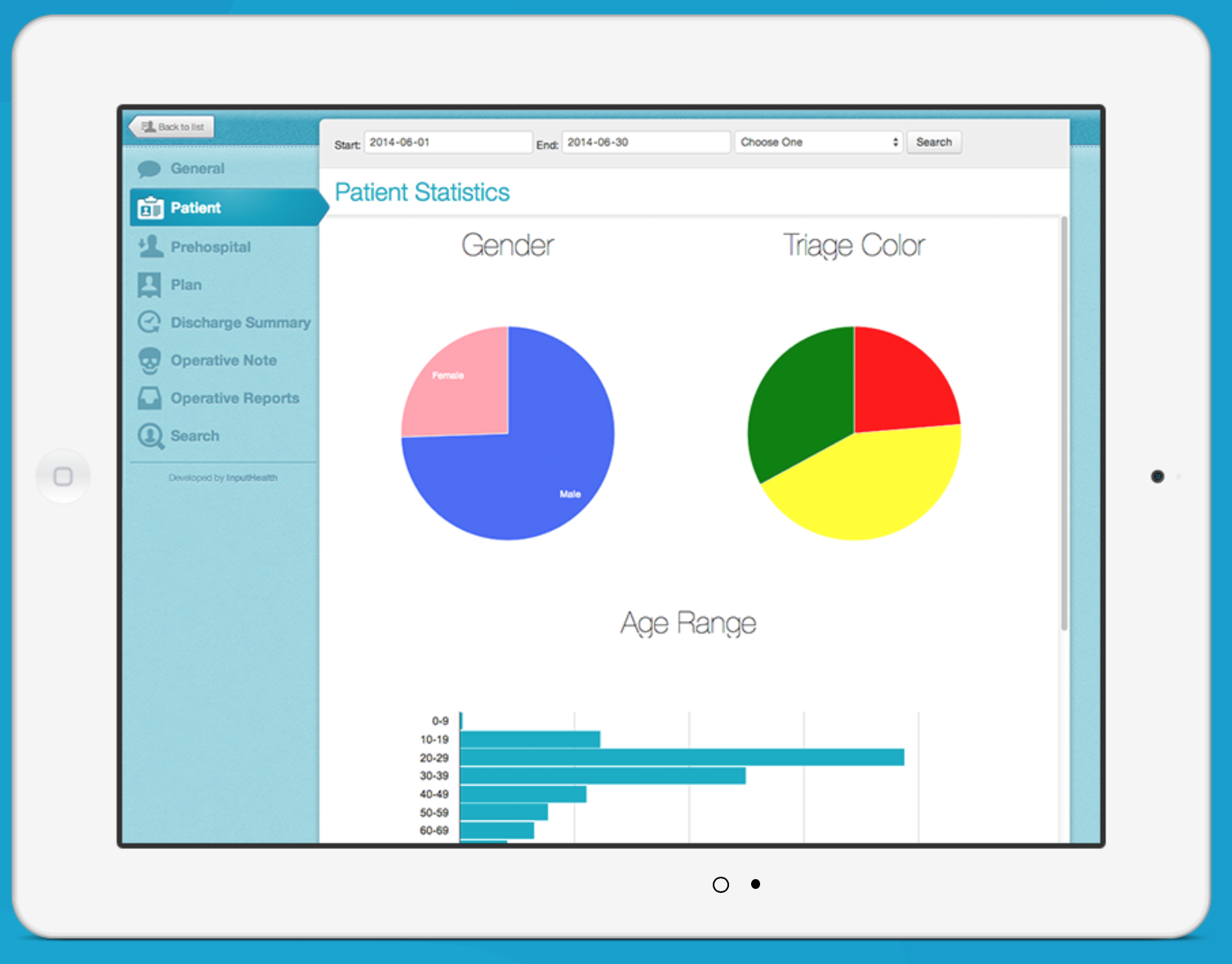UBC general surgery resident helps develop an app to support low-resource trauma centres around the world

UBC general surgery resident Eiman Zargaran
It wasn’t a complicated solution –— in fact, if anything, it was simple.
“There must have been thousands and thousands of forms,” says Eiman Zargaran. “I remember piles of trauma admissions records, stacked away in folders and boxes, waiting to be uploaded to the centre’s trauma database.”
Four years ago, this was the scene Dr. Zargaran, a UBC general surgery resident, witnessed on his first day at Groote Schuur Hospital in Cape Town, South Africa –— one of the busiest trauma centres in the world.
Arriving for what he thought was only a brief research placement soon developed into a career-changing opportunity when Dr. Zargaran came face-to-face a much larger challenge: a massive trauma centre, without the time or manpower to keep their trauma database up to date, let alone evaluate the paper records and use them to better inform trauma care.
Instead of helping to transcribe the data and make a dent in the record pile, Dr. Zargaran, together with his research supervisor and closest mentor, Morad Hameed, an Assistant Professor of Surgery at UBC and trauma surgeon at Vancouver General Hospital, decided to look one step further, towards a ground-breaking solution that would change the face of injury surveillance altogether.
The solution? Develop a tablet-based application that could be used by front-line trauma clinicians in Cape Town to complete their medical charting duties at the point of care.
“It was a pretty exciting idea,” says Dr. Zargaran. “In low-resource areas, there’s just not the time and resources available to dedicate to injury surveillance and analysis. Our research group, alongside the trauma directors at Groote Schuur, thought why not harness the power of mobile technology, like an iPad-mini, and create an app that could streamline the charting process, essentially removing the time and resources associated with maintaining a paper-based database.”
Four years later, and the application, known as the electronic Trauma Health Record, or eTHR, is making waves in Cape Town.
Since implementation in the spring of 2014, the app — which also analyzes the initial assessment, resuscitation, operation and discharge data to generate a real-time and self-populating trauma registry — has logged well over 15,000 trauma patients.

A screenshot of the Electronic Trauma Health Record (eTHR)
“The app has become embedded in the culture of charting patients in Cape Town,” says Dr. Zargaran, who remains in close contact with the Director of the Trauma Department at Groote Schuur Hospital, Andy Nicol, who played a critical role in the implementation of the eTHR.
Today, trauma clinicians at Groote Schuur Hospital are capturing a wealth of trauma care data — data they had never thought to collect before.
“The hospital went from capturing only basic admission data, to becoming one of the most sophisticated real-time trauma databases across low-income countries, collecting information on everything from procedures to patient outcomes,” explains Dr. Zargaran.
Not only are clinicians at Groote Schurr Hospital now using the records to gain insight into patterns and causes of trauma in the region, but strengthen injury prevention and improve trauma care delivery.
But the transformation at Groote Schurr Hospital didn’t happen overnight.
It would take bringing together an expert team of physicians and software designers, and finding further financial support and resources, before the application could take off. Most importantly, it would mean supporting a dramatic cultural shift, which, thanks to the innovative spirit of the South African trauma doctors, took place with relative ease.
From beta to launch
Several months later, after consultation and collaboration with other clinicians, data ethnographers, as well as medical software developers at InputHealth, Dr. Zargaran and Dr. Hameed returned to Cape Town with a prototypical application to test the waters.
“A lot of people had their doubts about how feasible it would be,” recalls Dr. Zargaran. “They were worried about the tablets going missing, or not having access to a reliable internet connection.”
But Dr. Zargaran and the team pressed on — and the beta, and second trip to Cape Town proved successful.
Now all that remained was the question of how Dr. Zargaran, a surgical resident with a demanding clinical schedule, would be able to find the time and resources to develop and implement the application.
Fortunately, with encouragement from Dr. Hameed, Dr. Zargaran found UBC’s Clinician Investigator Program, a two-year program designed to provide a combined research and clinical training stream for residents in specialty programs. For Dr. Zargaran, acceptance into the CIP would not only mean two years of protected research time, but financial support to move forward on the application.
In 2012, Zargaran became one of only 7 residents accepted into the CIP each year. And, by 2013, the eTHR team had garnered a host of awards for their research, including the prestigious Rising Star in Global Health Grand Challenges Award — a prize valued at $100,000 and awarded to ‘bold ideas with big impact.’
Shortly after receiving the Grand Challenges Award, Dr. Zargaran was back on a plane to Cape Town, where he would spend the next 18 months seeing the project move through to full implementation with the support of his project supervisor, Dr. Hameed.
For Dr. Siân Spacey, director of UBC’s CIP, it’s great to see residents, like Dr. Zargaran, making such a global impact.
“We’re incredibly proud of Eiman,” says Dr. Spacey. “He’s a very motivated individual, and we’re glad that the Clinician Investigator Program was able to provide him with the time and funding to support his research goals.”
Helping to change the face of injury surveillance
Today, Dr. Zargaran has returned to Vancouver, where he’s now completing his final years of general surgery residency. But the work with eTHR is not over — in fact, as Dr. Zargaran sees it, it’s only just the beginning.

Eiman Zargaran
Dr. Zargaran is now part of the growing eTHR team — which includes the project supervisor Dr. Hameed, Vancouver-based physician and President of Input Health, Damon Ramsey, and their lead software developer, James Shirlaw.
As the team has grown, so too has the application’s reach, with eTHR now ready to be implemented in Paraguay, and expected to be set up in Columbia over the coming months, followed by Guatemala next spring.
“You always have to be pushing the envelope,” says Dr. Zargaran, reflecting on his journey over the past several years.
There’s no doubt that Dr. Zargaran — who hopes to serve as a physician-scientist, balancing his clinical responsibilities as a surgeon with his appetite for research in trauma care — will do just that. Over the long term, Dr. Zargaran says he’ll continue pursuing his passion for building trauma care capacity in under-resourced areas around the world — searching for ways of using scientific methods and data to improve injury control and trauma care delivery worldwide.